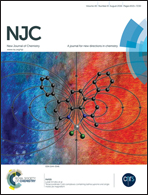Hydrothermal synthesis of two supramolecular inorganic–organic hybrid phosphomolybdates based on Ni(ii) and Co(ii) ions: structural diversity and heterogeneous catalytic activities†
Abstract
Two new hybrid compounds based on phosphomolybdates, namely (NHEPH2)5[NiII(P4Mo6O31)2]·6H2O (1) and {(NHEPH2)2[CoII(H2O)6]}[P2Mo5O23]·2H2O (2) (NHEP = N-(2-hydroxyethyl)-piperazine), have been synthesized under hydrothermal conditions and characterized by elemental analyses, IR, TGA, single crystal X-ray diffraction and PXRD studies. In compound 1, Ni(II) is sandwiched between two {P4Mo6O31}6− clusters and the residual negative charges are neutralized by NHEPH22+. In compound 2, the [P2Mo5O23]6− ion exists as a discrete moiety and the negative charges are compensated by both [Co(H2O)6]2+ and NHEPH22+. The extensive hydrogen bonding involving the organic cations and water molecules yielded three-dimensional (3D) open framework structures in these systems. These phosphomolybdate based compounds showed good catalytic efficiency in heterogeneous oxidation of styrene in the presence of an environmentally benign oxidant, H2O2, under mild conditions.


 Please wait while we load your content...
Please wait while we load your content...